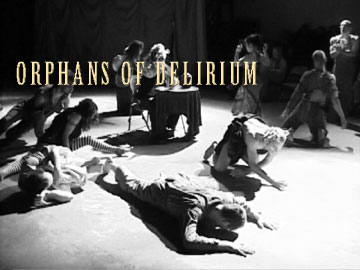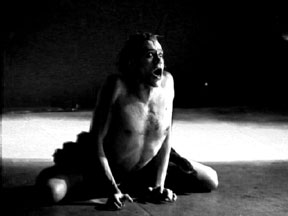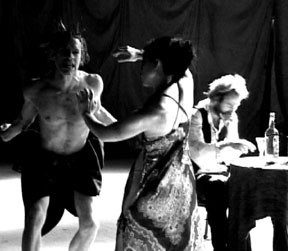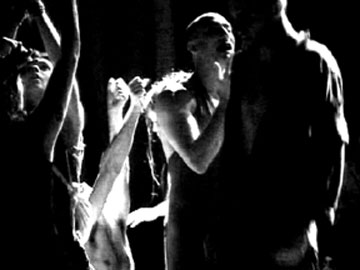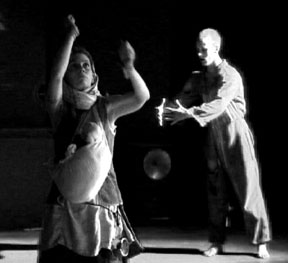Film Review by David Finkelstein
for filmthreat.com (4 stars out of five)
ORPHANS OF DELIRIUM (2004; 85 min. USA)
At the onset of “Orphans of Delirium,” Antero Alli’s compelling documentary about his own practices as a director of a troupe of actors engaged in “paratheatrical research,” Alli explains this term. His work uses the techniques of theater, but not to put on a play or stage conventional improvisations. Instead, the actors train to access different “energy centers” within the body, and to unleash this energy through vocalizing, through movement, and through language. Each of the twelve participants works with Alli to identify a “character,” such as Magician, Fool, or Salamander, which is not like a role in a traditional play, but more like an archetype which is used as a lens; a description of how that person habitually processes feelings.
The goal of this work? Alli describes it as “getting high,” which he clearly means here in the sense of higher consciousness, ecstasy, and ds usual practice in paratheatrical work insofar as they are filmed and performed in front of a small audience; normally there is no audience invited to watch the work. Alli notes, in his voice-over narration, that every paratheatrical workshop develops its own goal and focus. “Getting high” seemed to him to describe the nature of the particular group which formed for the workshop documented in this film.
Alli has been doing this work since 1977. His work is partly inspired by the experiments of Polish theater director Jerzy Grotowski. The group’s preparatory work took four months of intensive training. A key concept for the work is “no-form” or “the void,” which is seen both as a willingness to experience energy directly, without a conceptual framework, and also as a universal source of creativity, which one can learn to access.
The film alternates between excerpts from the rituals themselves and a three-way discussion between Alli and workshop participants Paradox Pollack and Nick Walker. Each ritual is introduced by a synopsis, written after the fact by Alli, which highlights key elements to help the viewer make sense of the “no form.” In the rituals, each actor uses props and costumes developed for his or her character. They vocalize, often in long, keening cries which sound like they are coming from deep within the body and psyche. Some are engaged in wild, unpredictable yet entirely organic movements; others are still and quiet. They often seem to be ignoring each other, but then suddenly their voices will all sync up on a chord, or two of them will become involved in a wildly physical confrontation. The work is ably supported by the music of long time collaborator Sylvi Alli.
The actors in these rituals look like a cross between a person, an elementary force such as a river or a storm, and a wild animal. Watching the rituals is a little like looking through a window at a particularly dramatic and captivating bit of weather. It doesn't look like a "play", but it is absolutely mesmerizing to watch these elemental forces gathering themselves and affecting each other.
The discussion and analysis of the work between Alli, Pollack and Walker is helpful and engaging. Pollack isn’t a great analyzer, but his enthusiasm for talking about the work is a great catalyst for the conversation. Walker, who has worked with Alli on many projects, speaks beautifully and knowledgeably about how the work operates, and makes interesting comparisons to his own work as an Aikido teacher.
There is some talk in the discussion about the need for each actor to work autonomously yet allow the space for the autonomy of others. I must say, however, that as many groups, the highly aggressive energy of the male performers, when unleashed, takes up so much psychic space in the room that the women's characters never seem to be quite as fully articulated (there are also more men than women in this group).
Alli discusses candidly his ambivalence about using a video to document this work, which is normally done in private, and also about the inherently elitist, arcane nature of his pursuit. Luckily for us, his natural human impulse to wish to share his amazing discoveries wins out, and the film gets made.
The film ends, crucially, with a series of short interviews with the workshop participants. Most of them do not identify themselves as “actors,” which underscores the fact that the aim of the work is more spi where to access and channel these sources, the participants are learning how, paradoxically, through an act of surrender they are able to gain more control. For example, one man speaks of how a lot of the energy in the work is quite violent, and how it became “fun to play with that violence” in a way which is safe.
“Orphans of Delirium” is a compelling introduction to a way of exploring and liberating one’s spiritual energy which may be too intense for most people to practice, but which nevertheless reveals to us the energy structures which underlie our experiences.
To "Orphans of Delirium" main page
